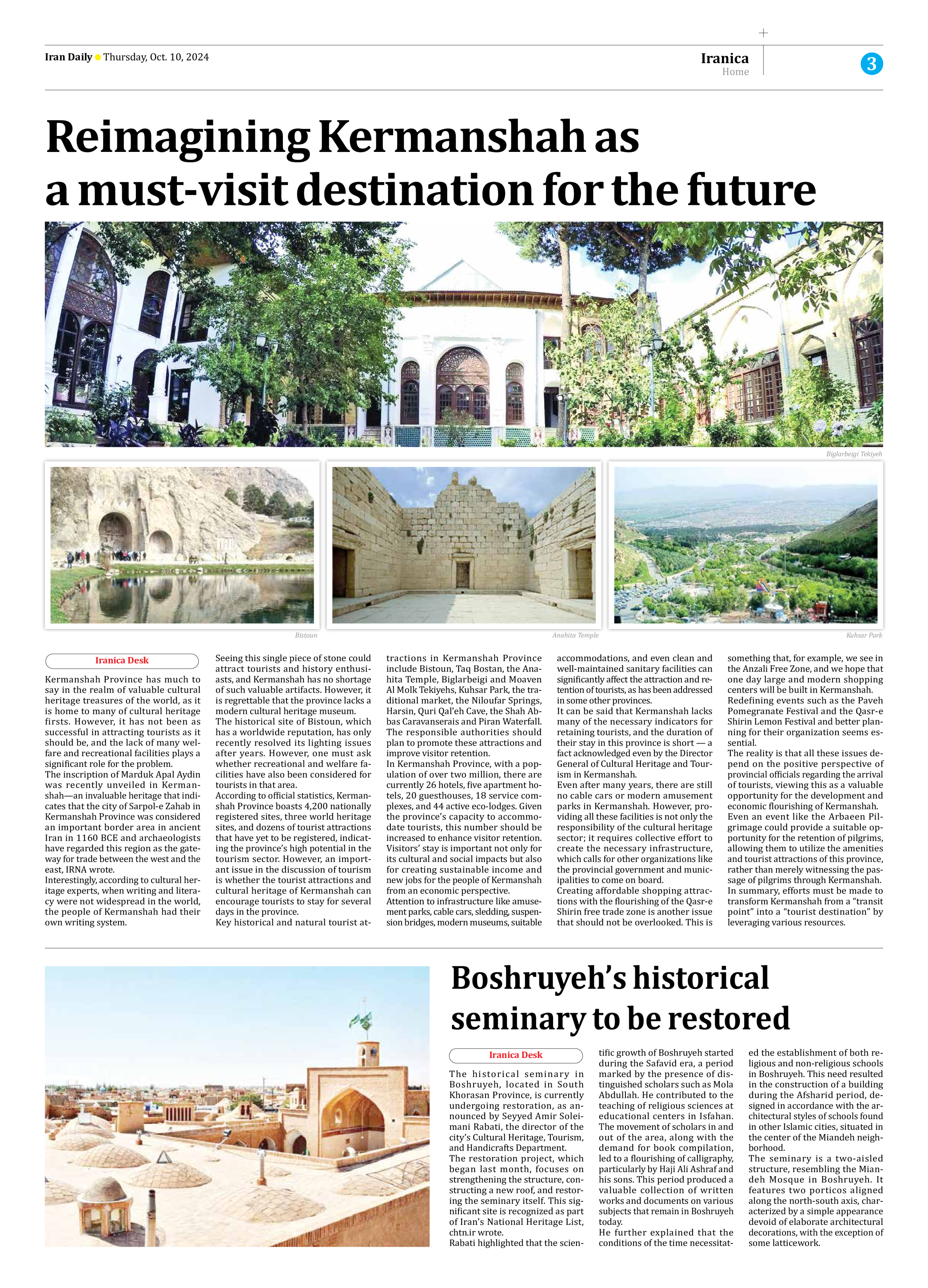
Reimagining Kermanshah as a must-visit destination for the future
Kermanshah Province has much to say in the realm of valuable cultural heritage treasures of the world, as it is home to many of cultural heritage firsts. However, it has not been as successful in attracting tourists as it should be, and the lack of many welfare and recreational facilities plays a significant role for the problem.
The inscription of Marduk Apal Aydin was recently unveiled in Kermanshah—an invaluable heritage that indicates that the city of Sarpol-e Zahab in Kermanshah Province was considered an important border area in ancient Iran in 1160 BCE and archaeologists have regarded this region as the gateway for trade between the west and the east, IRNA wrote.
Interestingly, according to cultural heritage experts, when writing and literacy were not widespread in the world, the people of Kermanshah had their own writing system.
Seeing this single piece of stone could attract tourists and history enthusiasts, and Kermanshah has no shortage of such valuable artifacts. However, it is regrettable that the province lacks a modern cultural heritage museum.
The historical site of Bistoun, which has a worldwide reputation, has only recently resolved its lighting issues after years. However, one must ask whether recreational and welfare facilities have also been considered for tourists in that area.
According to official statistics, Kermanshah Province boasts 4,200 nationally registered sites, three world heritage sites, and dozens of tourist attractions that have yet to be registered, indicating the province’s high potential in the tourism sector. However, an important issue in the discussion of tourism is whether the tourist attractions and cultural heritage of Kermanshah can encourage tourists to stay for several days in the province.
Key historical and natural tourist attractions in Kermanshah Province include Bistoun, Taq Bostan, the Anahita Temple, Biglarbeigi and Moaven Al Molk Tekiyehs, Kuhsar Park, the traditional market, the Niloufar Springs, Harsin, Quri Qal’eh Cave, the Shah Abbas Caravanserais and Piran Waterfall. The responsible authorities should plan to promote these attractions and improve visitor retention.
In Kermanshah Province, with a population of over two million, there are currently 26 hotels, five apartment hotels, 20 guesthouses, 18 service complexes, and 44 active eco-lodges. Given the province’s capacity to accommodate tourists, this number should be increased to enhance visitor retention.
Visitors’ stay is important not only for its cultural and social impacts but also for creating sustainable income and new jobs for the people of Kermanshah from an economic perspective.
Attention to infrastructure like amusement parks, cable cars, sledding, suspension bridges, modern museums, suitable accommodations, and even clean and well-maintained sanitary facilities can significantly affect the attraction and retention of tourists, as has been addressed in some other provinces.
It can be said that Kermanshah lacks many of the necessary indicators for retaining tourists, and the duration of their stay in this province is short — a fact acknowledged even by the Director General of Cultural Heritage and Tourism in Kermanshah.
Even after many years, there are still no cable cars or modern amusement parks in Kermanshah. However, providing all these facilities is not only the responsibility of the cultural heritage sector; it requires collective effort to create the necessary infrastructure, which calls for other organizations like the provincial government and municipalities to come on board.
Creating affordable shopping attractions with the flourishing of the Qasr-e Shirin free trade zone is another issue that should not be overlooked. This is something that, for example, we see in the Anzali Free Zone, and we hope that one day large and modern shopping centers will be built in Kermanshah.
Redefining events such as the Paveh Pomegranate Festival and the Qasr-e Shirin Lemon Festival and better planning for their organization seems essential.
The reality is that all these issues depend on the positive perspective of provincial officials regarding the arrival of tourists, viewing this as a valuable opportunity for the development and economic flourishing of Kermanshah.
Even an event like the Arbaeen Pilgrimage could provide a suitable opportunity for the retention of pilgrims, allowing them to utilize the amenities and tourist attractions of this province, rather than merely witnessing the passage of pilgrims through Kermanshah.
In summary, efforts must be made to transform Kermanshah from a “transit point” into a “tourist destination” by leveraging various resources.







